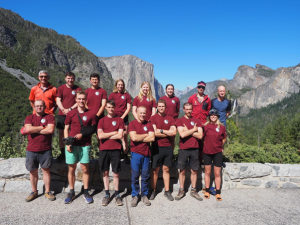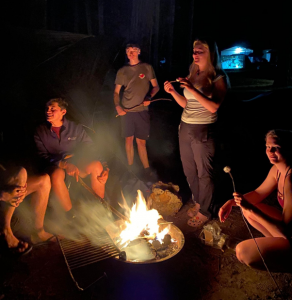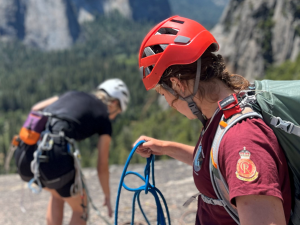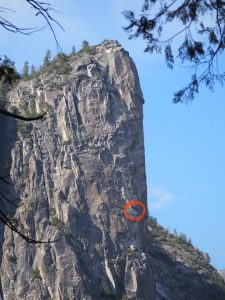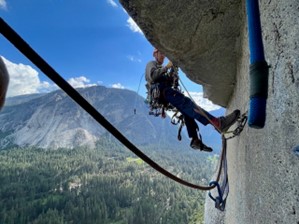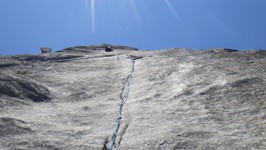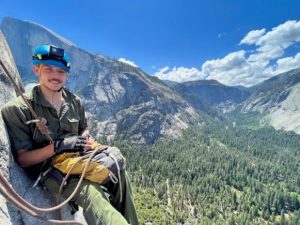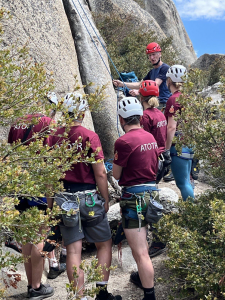“On the wall, your life in the hands of your climbing partner – It’s like one big trust exercise. The exercise has 100% made us all friends for life” OCdt Hibbs
OCdt Smyth
“I believe that my mental and physical resilience has improved during this trip; from being able to look at a rock face and understand how I am able to tackle a certain situation on the wall.”
Introduction
Ex Northern Ahawanee Warrior 23 was an overseas Adventure Training (AT) exercise organised by Aberdeen and Tayforth Officers Training Regiment (ATOTR). The exercise took place in the State of California, USA as a Type 3 Rock Climbing Expedition, conducted over 7-23 June 23. The event was open to all OCdts and staff across Aberdeen and Tayforth Officer Training Corps.
Aim
The aim of the exercise was to deliver foundation level training for personnel who were not qualified but also to provide continuation training for those already qualified at foundation level. Ex Northern Ahawanee Warrior 23 formed part of a long-term development plan potentially culminating in an ascent of a big-wall (multi-day) rock climb in Yosemite Valley. Northern Ahawanee Warrior 23 also aimed to provide opportunities to foster team work and encourage the development of leadership, physical fitness and emotional resilience.
Planning
Planning for the exercise began in November 2022 to have the event in place in good time. On completion of the initial outline plan for the event the JSATFA process was commenced and the relevant clearances applied for. All unit personnel were eligible providing they were fit to attend. The initial planning figure was for 15 pax, consisting of six OCdts who would attend the Rock Single-Pitch Foundation course (RSF), four OCdts who were already RSF qualified and five instructors.
Travel
The travel plan consisted of travel by unit transport from Gordon Bks, Aberdeen to Edinburgh Airport and flights from Edinburgh to San Jose, California via Atlanta. Chrysler Pacifica 7-seat minivans were hired at the airport and utilised throughout the exercise.
Equipment
Due to a shortfall of availability of equipment at loan pool stores, we were short of climbing equipment for the exercise. ATG(A) sanctioned the purchase of equipment from DMM to cover the shortfall and sanctioned the hire of specialised Big Wall equipment (portaledge). However, there was no availability of this equipment in Yosemite, so the Big Wall route had to be selected bearing the shortfall in mind.
Communications
Personal mobile phones were used where required during the event. There were some areas which provided issues with mobile signal. As most phone networks do not include the USA in their free data roaming packages, this turned out to be expensive. A few individuals purchased USA SIM cards, which helped communications. Prior to and during the exercise the Signal App was used for communication. This proved very useful. The intention was to purchase walkie talkies for the communications with the big wall team, but there was nowhere within Yosemite Valley that sold these.
Weather
Phase one was based in the Lake Tahoe region. The weather during phase one was challenging, due to a pattern of afternoon storms. One of the climbing areas planned was unsuitable (Meyers Area) due to water run-off from melting snow and rain. Lake Tahoe sits at around 6000ft above sea level and the area had vast amounts of snow over the winter season. This meant that some of the climbing areas were not suitable, due to the approach still being covered in snow. Night time temperatures were under ten degrees Centigrade, with daytime temperatures reaching the low twenties.
The weather during phase two was more settled. Yosemite Valley is around four thousand feet above sea level and temperatures in the Valley were higher, often touching in the high twenties in the late afternoon, which was challenging for rock climbing activities. Climbs were made in the earlier part of the day to minimise the potential for heat related illnesses.
Accommodation
The first and last night in-country was based in hotels in Richmond and San Francisco respectively. These were both booked via the DTD group booking system.
The remaining nights utilised two separate campsites, for each of the two climbing phases. Phase one was based in the South Lake Tahoe region (Camp Richardson) and was selected due to the abundance of both single-pitch and multi-pitch climbing areas close to the campsite, which would allow the delivery of the five-day RSF course and would provide build-up training for those OCdts who were already RSF qualified. Phase two was based just outside Yosemite National Park (Yosemite Lakes) and would allow easy access to the multi-pitch venues and the Big wall routes of Yosemite Valley. As DTD does not offer the booking of campsites as an option both campsites were booked via their own respective websites.
Officer Cadet Involvement
An officer cadet was responsible for being duty student for each climbing day. This included keeping the daily journal and climbing log. They were also responsible for planning meals, purchasing food, organising cooking parties for evening meal and ensuring the campsite was clear at the end of the night to minimise the risks of wildlife entering the campsite.
At the end of the exercise all officer cadets helped account for the kit and equipment, accounted for the exercise budget and contributed to the Post Ex Report.
Photos and Multi-media
Several officer cadets had brought excellent quality cameras and some great photos were posted on Facebook, Twitter and Instagram. This will prove valuable for recruiting new officer cadet in the future and helping retain existing personnel.
One officer cadet was accepted on to the exercise partly due to his skills in drone flying, but there were restrictions on drone flying due to protected species of wildlife, which resulted in only a few areas where drone footage was possible. Drones are banned in Yosemite Valley, so no drone footage was possible during that phase. Despite this the OCdt climbing skills improved markedly as he already held the RSF award.
https://www.youtube.com/watch?v=sqHA_0xUFZY
Wildlife
Several bears were encountered during the Lake Tahoe phase. One raided our rubbish bag while a team meeting was taking place and was chased away by the campsite security. Another was encountered whist one of the instructors was trying to set up some top ropes. Bear boxes were available for food in Camp Ricardson but were not required for the Yosemite Lakes Campsite.
Other wildlife encountered without incident and included; rattlesnakes, a skunk and American Bald Eagles.
Benefit to the Unit
Ex Northern Ahawanee Warrior 23 has received interest from the Sandhurst Group who intend using some of the material from photos and videos in future recruiting events and publications.
As a unit, the exercise will help promote further interest in Adventure Training and will help promote attendance in the JSAT scheme, which will provide leaders and instructors for AT exercises in the future.
Transferrable skills will benefit the individuals who attended through self-management and self-discipline from camping for ten days. Individuals also had work as a team and all OCdts undertook the responsibility of duty student, being responsible for shopping, budgeting and keeping the daily log.
All these skills will be beneficial to the unit in non-AT exercises and will help foster leadership and teamwork.
Camp Richardson provided an excellent base for getting to the majority of the climbing areas planned for the delivery of the RSF course. Most crags were very accessible, with the longest approach being Phantom Spires. The approach to Main Spire could be reduced to fifteen minutes with an off-road capable vehicle. An extra fifteen minutes was required without the use of an offroad vehicle. Blue Granite Climbing Gym in South Lake Tahoe was used for the indoor element of the RSF course. This was an excellent facility, but was very expensive ($22 per head).
One of the climbing areas (Pie Shop) utilised was not in the SuperTopo South lake Tahoe guidebook. This turned out to be an excellent crag and information was sought through WWW.UKCLIMBING.COM & WWW.MOUNTAINPROJECT.COM , which provided enough information to allow this area to be utilised.
Climbing in Yosemite Valley
Yosemite Valley is an iconic venue for rock climbing, providing routes from single pitch rock climbs to multi-pitch routes over a mile high. One of the main objectives was to ascend a Yosemite Big Wall. The original route selected was the West Face of the Leaning Tower. This was selected due to being a relatively safe route with good protection and having natural ledges to sleep on, which did not require the shortfall of the portaledge. The approach to this route was reconnoitred by two of the instructors and on communicating with the Park Ranger Service this route was deemed unsuitable due to some of the fixed equipment being missing, resulting in a much higher grade than the guidebook suggested.
An alternative option, which had been completed by one of the instructors previously was the South Face of Washington Column. This route was selected and the team of Capt G Best, ATOTR, Lt Miles Hill, 3 Royal Welsh and OCdt Alastair Tod achieved success on the 16th June 2023. The team spent two nights on the wall and returned to the ground on the morning of their third day. This may be the first time an Officer Cadet has been successful in climbing a Big Wall during a UOTC Exercise.
Whilst the Big-wall team were on their route, the remainder of the group continued training and each group member was able to complete at least one multi-pitch climbing route in Yosemite. The Valley offers top quality climbing only a few minutes from the road. This convenience does mean that single pitch venues are busy and groups should attempt to get to the crag early. Parking in the Valley also requires an early start as after 10.00 it is very difficult to find any parking spaces within reasonable access of the climbing areas. Camp Four Car Park is convenient for most of the popular climbing venues. All Yosemite parking is free, with the exception of the valet parking at the Ahwanee Hotel, which is $10 per day.
Multi-pitch routes completed by the team included Swan Slab Gully, Sunnyside Bench Regular Route, Five Open Books, Munginella and Manure Pile Buttress, After Seven.
Conclusion
Exercise Northern Ahawanee Warrior 23 was originally planned for 2020, but postponed due to the COVID-19 pandemic. The attempt at a Big-Wall style rock climb had been the culmination of a Regimental rock climbing development plan and was extremely ambitious in nature. Yosemite Valley was specifically selected due to its quality and variety of climbing routes and its excellent rescue service, which would help mitigate the risks associated with climbing in some of the more remote climbing areas in the world. Six novice climbers attended and passed the Rock Single-pitch Foundation course and four other intermediate climbers undertook multi-pitch climbing training that allowed progression from Ex Northern Heights 22 in Arco, Italy. All four were able to ascend multi-pitch traditional climbing routes and would now be categorised as very accomplished second climbers. One of the three Officer Cadets was able to ascend the Big-Wall and was a very valuable member of the team.
There were challenges, in relation to communications, mobile phone signal, adverse weather, existing snowpack, roadworks, traffic congestion and parking issues within Yosemite Valley.
Some equipment proved valuable, including two tarps which allowed cover areas to eat during the rain. Some issued tents leaked and the 8-man base camp tent allowed some flexibility with this. Some cooking pots were purchased in-country and this allowed communal cooking by the group, which proved valuable.

